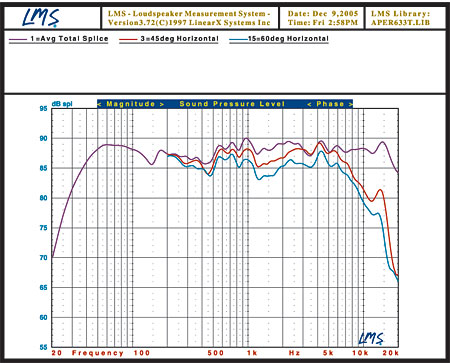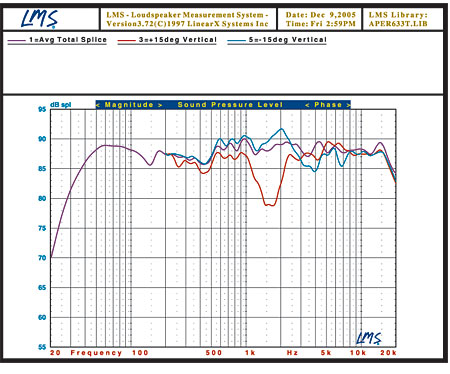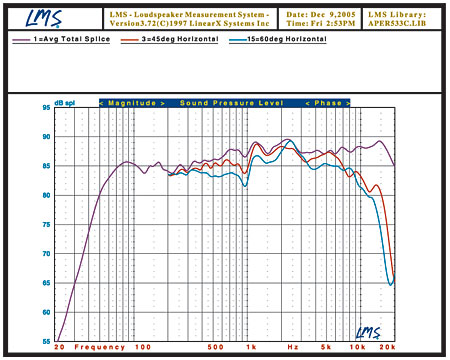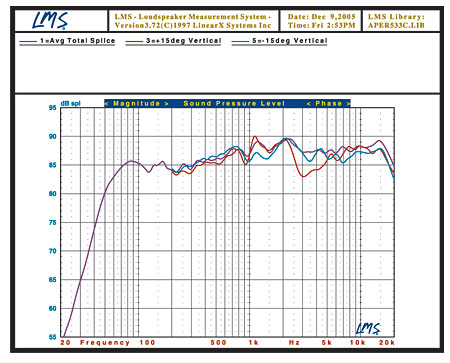Aperion Audio Intimus 633-T Surround Speaker System Measurements
The Intimus 633-T's ported enclosure was tuned to approximately 32Hz, with a minimum impedance of 4.7ohms at 115Hz. Based on the impedance curve, I would rate its nominal impedance at about 6 ohms. But the impedance at low frequencies is highly capacitive (-125 degrees at 32Hz). I would judge this speaker to be slightly harder to drive than average, though neither receiver I used—a budget-priced Outlaw in a small room, a flagship Denon in a larger space—had any obvious difficulty with it. The speaker's measured impedance was not noticeably more uniform than that of speakers that make no claims of a uniform impedance curve—as Aperion does. The speaker's sensitivity measured approximately 88dB/2.83V/m.
The horizontal front response of the 633-T is shown in Fig.1 (violet). This is the pseudo-anechoic response averaged over a 30-degree forward horizontal angle (+/-15 degrees), at tweeter height, combined with the nearfield responses of the woofers and port. The effective lower limit of the speaker was 27Hz (-10dB).

Fig.1: Aperion Intimus 633-T pseudo-anechoic response off the horizontal axis at 45 degrees (red) and 60 degrees (blue).
The averaged front horizontal response of the 633-T is unusually smooth, particularly at higher frequencies. This seemingly modest tweeter equals or betters a lot of the prestigious designs we've tested, at least on this measurement.
The most significant aberration in the overall response is the reduced output from 100-500Hz. This is the power region of most music, and may well have contributed to the slight leanness I sometimes heard. The dip at 150Hz is echoed by a small ripple in the speaker's impedance curve. Nevertheless, this measured average response is excellent for a speaker in this price range (and the measured high frequency response excellent for any speaker). The measurements shown here (and all the listening tests) were performed with the grille off, but putting it on made little difference in the measured results.
The 633-T's response at wide off-axis (horizontal) angles was good—certainly no worse than we have measured from many other well-engineered speakers. The vertical response shown in Fig.2 indicates that the 633-T should sound best if the listener's ears are positioned on or slightly below the tweeter axis; move above it and a significant suckout appears in the 1.5kHz region.

Fig.2: Aperion Intimus 633-T pseudo-anechoic response at 15 degrees above (red) and 15 degrees below (blue) the tweeter.
The center channel Intimus 533-VAC's cabinet was tuned to about 59Hz. Its minimum impedance was 5.84 ohms at 2.2kHz. I would rate the nominal impedance at 8 ohms. The sensitivity measured about 88db/2.83V/m. Like the 633-T, the impedance curve is no more uniform than that of most speakers. I would judge the 533-VAC to be of average difficulty to drive.
The averaged front horizontal response of the Intimus 533-VAC shown in Fig.3 (violet) was, if anything, even smoother than that of the 633-T, but with one significant difference. The midrange and low frequency response begins tapering off gradually at a very high frequency. While this may help compensate for placement atop a big screen television, it might also make the speaker sound rather lean and a little bright in some situations. Another way of looking at is that the woofer is not quite sensitive enough to match the output of the midrange (which starts contributing just below 1kHz or so). A small rise in the 1-3kHz region could also contribute to a degree of brightness.

Fig.3: Aperion Intimus 533-VAC pseudo-anechoic response off the horizontal axis at 45 degrees (red) and 60 degrees (blue).
The center's off-axis response held up well—an attribute (though not always) of a well-designed, three-way center channel speaker. There continues to be some emphasis in the 1-3kHz region, and a small dip around 1kHz likely resulting from interference between laterally positioned woofer and midrange (whose responses are overlapping in this region). But there are none of the severe off-axis suckouts that are endemic to two-way, woofer-tweeter-woofer horizontally configured designs.
The vertical off-axis response of the 533-VAC is good, and only slightly better below the tweeter axis than above (Fig.4). The grille was slightly more detrimental to the response than in the 633-T (its major negative effect was a 2dB dip at 5-6kHz).

Fig.4: Aperion Intimus 533-VAC pseudo-anechoic response at 15 degrees above (red) and 15 degrees below (blue) tweeter.
This is a good set of measurements typical of—and in some ways better than—the measurements we often see on many far more expensive speakers.—TJN
All figures: Violet curve: pseudo-anechoic response on tweeter axis, averaged across a 30-degree horizontal window, combined with nearfield woofer and port or passive radiator responses. All measurements were taken at 1-meter.





























































